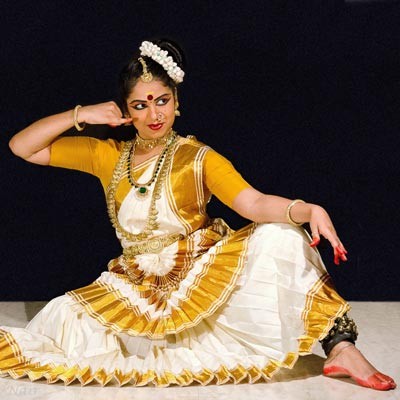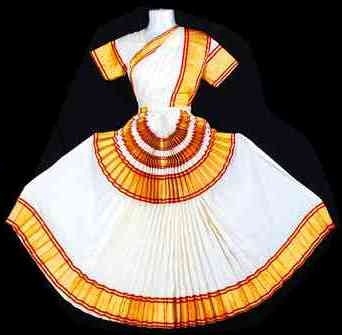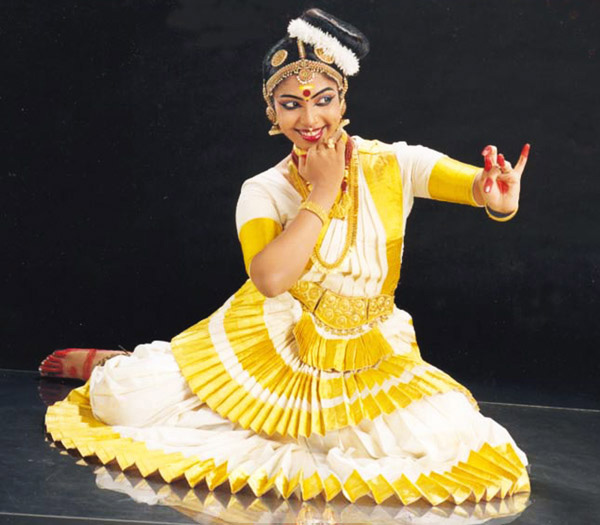- Home
- Indian Dances
- Mohiniattam Dance
Mohiniattam Dance- classical dance form of Kerala
Mohiniattam dance is one of the most elegant classical dances of India that originated from Kerala. It is also spelled as Mohiniyattam. The other famous classical dance of Kerala is Kathakali. The word Mohiniattam is derived from the word Mohini which means female avatar of lord Vishnu.
Mohiniattam is solo dance performed by women in most seductive and graceful way after extensive training. Of late even group dance is also performed. The music is usually Carnatic music with the dancer herself singing or vocalists sings for her. Like Bharatanatyam Mohiniattam also include seven elements like Cholkittu, Varnam, jatiswaram, padam and Tilana, Shlokam and Saptam. Usually the music is the mixture of Malayalam and Sanskrit language called as Maniparvala. This dance includes Lasya style of dancing done very gracefully.
Mohiniattam is a classical Indian dance form that originated in the southern state of Kerala. The name "Mohiniattam" is derived from two words: "Mohini," which refers to the enchantress form of the Hindu god Vishnu, and "attam," which means dance. Thus, Mohiniattam literally translates to "the dance of the enchantress."
This dance form is characterized by its graceful and fluid movements, intricate footwork, subtle facial expressions, and hand gestures known as mudras. Mohiniattam traditionally tells stories from Hindu mythology, particularly those related to Vishnu and Krishna, through expressive movements and gestures.
History and sequence of Mohiniattam dance
Mohiniattam also has its roots in Natya shastra written by Baratha Muni. According to some sources the first complete version of Natya Shastra was considered to have been completed between 200 BCE to 200 CE. However, some others mention the time frame between 500 BCE to 500 CE. It is a Hindu text which deals with performing arts. During British period all the dances had a great downfall. However around 1930 Vallathol Narayana Menon helped to revive the dance after taking out the ban on temple dancing in Kerala.
The theme of the dance includes love and
devotion to God especially lord Vishnu and Lord Krishna. It is quiet similar to
Bharatanatyam and Kathakali. The important postures include wide feet with bent
knees protruding outwards. The dance includes Nritta and Nrithya. Nritta form of dance is rhythmic which appears
at the beginning and at the end of dance form. In this the dancer tries to send
a spiritual message to the viewers. In Nritya the dancers express the
feelings and emotions silently with hand and facial expressions and body
motions. Even this dance form has various mudras which are expressed in Hasta Lakshana Deepika.

The dance developed in Kerala region which was believed to have an association with the ancient tradition of Lasya style. The temple sculptures in the states clearly depicts the various dance forms which include Mohiniattam. Some of the female sculptures in the temples at Trikodithanam and Kidangur Subramanya of 11th century shows pose from Mohiniattam. From 12th century onwards the textual evidence which playwrights and poets included Lasya theme.
By 16th century things started to change and improve. The 16th century book Vyavaharamala written by Mazhamangalam Narayanan Namboodiri mentions the term Mohiniattam due to some payment due to a Mohinittam dancer. By 18th century Sanskrit treatise Balarama Bharatam written by king of Travancore Karthika Thirunal Bala Rama Varma refers about Mohino Natana along with various other dance styles.
Maharaja Swathi Thirunal, was a prominent ruler and composer who made significant contributions to various art forms, including Mohiniattam. He was the ruler of the princely state of Travancore in the early 19th century. Swathi Thirunal composed numerous musical compositions specifically for Mohiniattam performances. These compositions, known as padams and varnams, are an integral part of Mohiniattam repertoire. His compositions often featured themes from Hindu mythology and were set to Carnatic ragas, providing a rich musical backdrop for Mohiniattam performances.
Colonial Era
During the colonial era in India, particularly in Kerala, Mohiniattam faced several challenges and underwent significant changes. One significant effect of colonialism on Mohiniattam was the decline in patronage and support for traditional art forms. With the decline of princely states and the erosion of the feudal system, many traditional art forms, including Mohiniattam, lost their royal patronage and financial support. This led to a decline in the status and popularity of Mohiniattam, as artists struggled to sustain themselves and their art.
By 19th century Mohiniattam was part of three important marriage rituals. They were thali-kettu-kalyanam, menstrual marriage, sambhandham. After Mohiniattam indictment the three marriage rituals were deduced to one called Kalyanam. According to Justine Lemos, Maharajas had to forcefully ban the dance form due to the compulsion from the British rule. However, the historical evidence does not give any clear indication on the ban nor any law. Lemos does mention about the rewards given to these dancers as well as the act enacted during 1931 and 38. The law banned dancing in temples but in 1940 the ban was partially repealed by allowing voluntary dances in the temples without any payment, this led to protest and public riots. Mohiniattam artists demanded that they should receive payment from the state or by the viewers but were not paid by the state.
Costume of Mohiniattam Dance

The
costume includes a white kasavu saree with golden border with a white blouse
and golden border to it. The saree has lot of pleats in the front which helps
the dancers in foot movement and also gives a beautiful design on the saree.
The hair is tied like a bun on the left side of the body with lot of flowers
surrounding the bun. The dancers wear simple jewellery and make up. The
jewelleries that are worn by the dancers include waistband, bangles, necklace
and anklets. The fingers of hands and
legs are dyed with mehndi or red colour dye. The basic movement includes hands
and foot movement. The basic posture includes sitting half with knee bent
outwards
Repertoire
Like most of the classical dance form the repertoire of Mohiniattam includes Nritta and Nritya as mentioned in the Natya Shastra. The specialty of Mohiniattam is that it follows Lasya type of dance which showcases a more gentle, graceful and feminine form of dance in Ekaharya Abhinaya form also known as solo dance.
Nritta" refers to the pure dance sequences that focus primarily on rhythmic movements, footwork, and abstract dance patterns without much emphasis on storytelling or expression of emotions. Nritta sequences in Mohiniattam typically feature intricate footwork, graceful movements, and rhythmic variations without story telling.
"Nritya" refers to the expressive aspect of the dance form, where the dancer conveys emotions, stories, and themes through facial expressions, hand gestures (mudras), and body movements. Nritya sequences in Mohiniattam are characterized by their lyrical and graceful movements, which are used to depict narratives from mythology, poetry, and literature.
Nritya in Mohiniattam often involves the interpretation and portrayal of characters and emotions, with the dancer embodying various roles and personas. the basic dance units in Mohiniattam are known as atavukal which are grouped into four Taganam, Jaganam, Dhaganam and Sammisram.
Some of the key elements of the Mohiniattam repertoire include:
Cholkettu: Cholkettu refers to the opening piece of a Mohiniattam performance.
Jatiswaram: Jatiswaram is a pure dance composition in Mohiniattam, characterized by intricate footwork, graceful movements, and rhythmic patterns.
Padams: Padams are expressive pieces in Mohiniattam that focus on storytelling and emotion.
Thillana: Thillana is a lively and energetic composition in Mohiniattam, usually performed towards the end of a recital.
Ashtapadis: Ashtapadis are lyrical compositions attributed to the 12th-century poet Jayadeva, which are commonly performed in Mohiniattam recitals.
Slokas and Shlokas: Mohiniattam repertoire may also include recitations of slokas (religious verses) and shlokas (poetic verses) from Hindu scriptures and literary texts.
Instruments used
The instruments used in Mohiniattam include Mridangham, Idakka, Flute, Violin, Veena and Cymbals. There are four groups in Mohiniattam they are Taganam, Jaganam, Dhaganam and Sammmisram. The music is in Carnatic style. The song is called as Manipravalam which is a mixture of Sanskrit, Malayalam and Tamil language.
Some
famous dancers include Sunanda Nair, Pallavi Krishan, Radha Dutta, Kalyani
Kuttiamma Bharti Shivaji and many more
Update on coronavirus in India
Affiliate Disclosure:
If you make any purchase via a link on this site, I may receive a small commission with no added cost to you.



